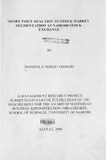| dc.contributor.author | Ombajo, Mandala N | |
| dc.date.accessioned | 2013-05-11T12:18:43Z | |
| dc.date.available | 2013-05-11T12:18:43Z | |
| dc.date.issued | 2006-08 | |
| dc.identifier.citation | Masters thesis University of Nairobi (2006) | en |
| dc.identifier.uri | http://erepository.uonbi.ac.ke:8080/xmlui/handle/123456789/22090 | |
| dc.description | Degree of Master of Business Administration | en |
| dc.description.abstract | In February 2001, NSE was segmented into three market segments MIMS, AIMS and
FISMS. Segmentation of security markets has its adverse effects. Shareholders of firms
moved from the main market to subsidiary market (AIMS) might find it difficult or incur
additional costs in liquidating off their shares; and potential investors could lose interest
in the firms thus making it difficult raising funds for worthwhile projects and this
ultimately raises the cost of capital. The degree of investor recognition could be affected
and thus ultimately affect the share returns which again has a bearing on the cost of
capital. However segmentation of the market as a form of financial innovation could
improve efficiency leading to a reduction in the cost of capital without a commensurate
increase in systematic risk.
This paper thus seeks to determine the extent to which market segmentation affected the
share prices of the listed firms, liquidity and investor recognition. To document the return
patterns surrounding the segmentation announcement as well as obtain residuals for
hypothesis testing, the event study methodology pioneered by Fama et al. (1969) will be
used to measure the stock price effects of NSE segmentation. An empirical study will be
conducted using NSE listed firms as the population.
The findings of the study is that share prices and liquidity were adversely affected by
segmentation and thus it was a punishment to firms that were listed in AIMS without a
commensurate reduction in cost of capital or financial innovation benefits. | en |
| dc.language.iso | en | en |
| dc.publisher | University of Nairobi. | en |
| dc.title | Share price reaction to stock market segmentation at Nairobi Stock Exchange | en |
| dc.type | Thesis | en |
| local.publisher | School of Business Studies | en |

